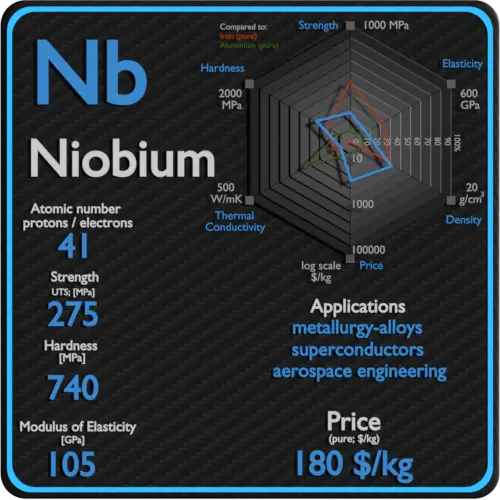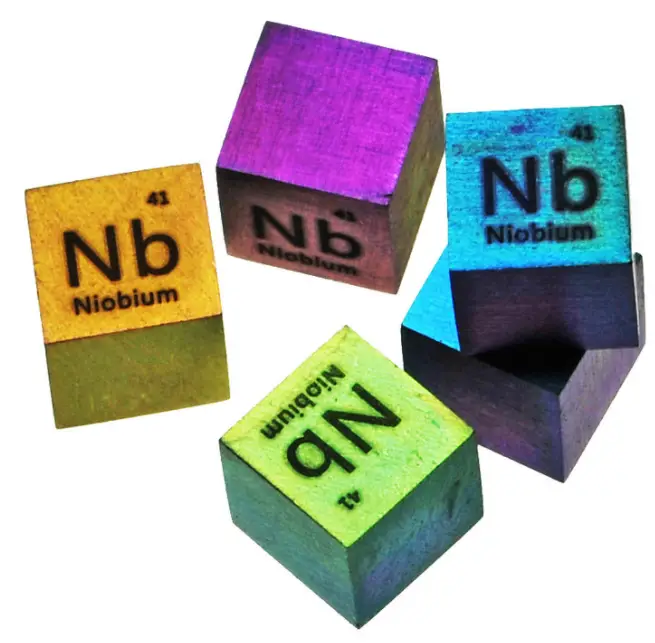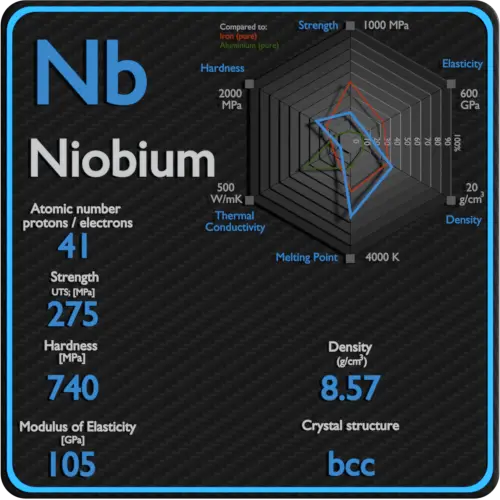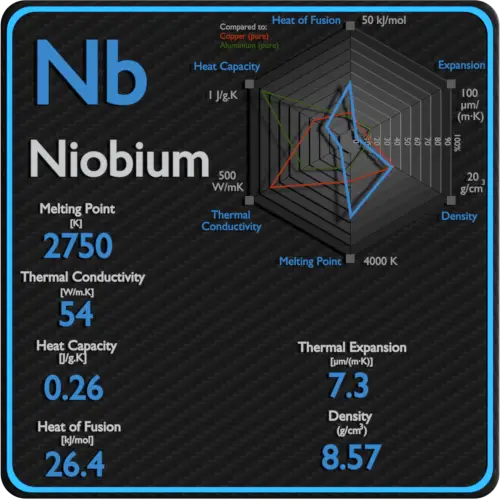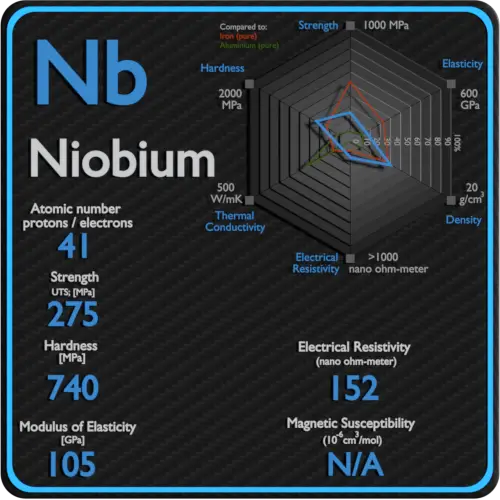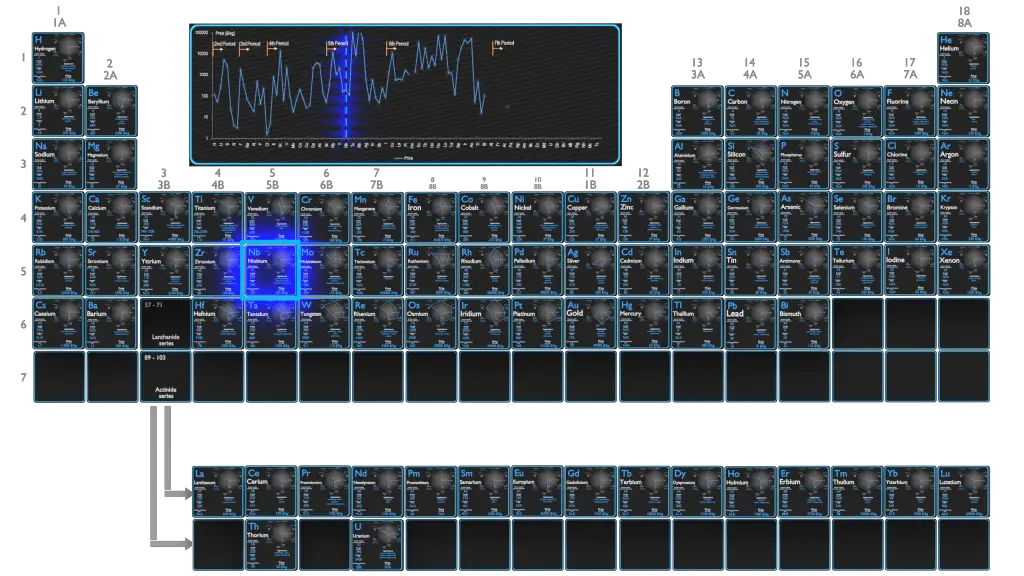About Niobium
Niobium is a soft, grey, ductile transition metal, often found in the minerals pyrochlore (the main commercial source for niobium) and columbite.
Summary
| Element | Niobium |
| Atomic number | 41 |
| Element category | Transition Metal |
| Phase at STP | Solid |
| Density | 8.57 g/cm3 |
| Ultimate Tensile Strength | 275 MPa |
| Yield Strength | 70 MPa |
| Young’s Modulus of Elasticity | 105 GPa |
| Mohs Scale | 6 |
| Brinell Hardness | 740 MPa |
| Vickers Hardness | 1300 MPa |
| Melting Point | 2477 °C |
| Boiling Point | 4744 °C |
| Thermal Conductivity | 53.7 W/mK |
| Thermal Expansion Coefficient | 7.3 µm/mK |
| Specific Heat | 0.26 J/g K |
| Heat of Fusion | 26.4 kJ/mol |
| Heat of Vaporization | 682 kJ/mol |
| Electrical resistivity [nanoOhm meter] | 152 |
| Magnetic Susceptibility | N/A |
Applications of Niobium
Niobium consumption is dominated by its use as additive to high strength low alloy steel and stainless steel for oil and gas pipelines, car and truck bodies, architectural requirements, tool steels, ships hulls, railroad tracks. However, there are a number of other applications for niobium metal and its compounds. Although niobium has many applications the majority is used in the production of high-grade structural steel. The second largest application for niobium is in nickel-based superalloys. Niobium-tin alloys are used as superconducting magnets.
Production and Price of Niobium
Raw materials prices change daily. They are primarily driven by supply, demand and energy prices. In 2019, prices of pure Niobium were at around 180 $/kg.
In general, niobium is found always together with tantalum, manganese and iron. The ores were broken, grinded and refined by gravity separation or flotation. The niobium ore is further purified by subsequent chemical treatment, depending on the used technique the Niobium concentrate is available as oxide, salt or chloride. Out of 44,500 tonnes of niobium mined in 2006, an estimated 90% was used in high-grade structural steel. The second largest application is superalloys.
Source: www.luciteria.com
Mechanical Properties of Niobium
Strength of Niobium
In mechanics of materials, the strength of a material is its ability to withstand an applied load without failure or plastic deformation. Strength of materials basically considers the relationship between the external loads applied to a material and the resulting deformation or change in material dimensions. In designing structures and machines, it is important to consider these factors, in order that the material selected will have adequate strength to resist applied loads or forces and retain its original shape. Strength of a material is its ability to withstand this applied load without failure or plastic deformation.
For tensile stress, the capacity of a material or structure to withstand loads tending to elongate is known as ultimate tensile strength (UTS). Yield strength or yield stress is the material property defined as the stress at which a material begins to deform plastically whereas yield point is the point where nonlinear (elastic + plastic) deformation begins.
See also: Strength of Materials
Ultimate Tensile Strength of Niobium
Ultimate tensile strength of Niobium is 275 MPa.
Yield Strength of Niobium
Yield strength of Niobium is 70 MPa.
Modulus of Elasticity of Niobium
The Young’s modulus of elasticity of Niobium is 70 MPa.
Hardness of Niobium
In materials science, hardness is the ability to withstand surface indentation (localized plastic deformation) and scratching. Brinell hardness test is one of indentation hardness tests, that has been developed for hardness testing. In Brinell tests, a hard, spherical indenter is forced under a specific load into the surface of the metal to be tested.
Brinell hardness of Niobium is approximately 740 MPa.
The Vickers hardness test method was developed by Robert L. Smith and George E. Sandland at Vickers Ltd as an alternative to the Brinell method to measure the hardness of materials. The Vickers hardness test method can be also used as a microhardness test method, which is mostly used for small parts, thin sections, or case depth work.
Vickers hardness of Niobium is approximately 1300 MPa.
Scratch hardness is the measure of how resistant a sample is to permanent plastic deformation due to friction from a sharp object. The most common scale for this qualitative test is Mohs scale, which is used in mineralogy. The Mohs scale of mineral hardness is based on the ability of one natural sample of mineral to scratch another mineral visibly.
Niobium is has a hardness of approximately 6.
See also: Hardness of Materials
Niobium – Crystal Structure
A possible crystal structure of Niobium is body-centered cubic structure.
In metals, and in many other solids, the atoms are arranged in regular arrays called crystals. A crystal lattice is a repeating pattern of mathematical points that extends throughout space. The forces of chemical bonding causes this repetition. It is this repeated pattern which control properties like strength, ductility, density, conductivity (property of conducting or transmitting heat, electricity, etc.), and shape. There are 14 general types of such patterns known as Bravais lattices.
See also: Crystal Structure of Materials
Crystal Structure of Niobium

Thermal Properties of Niobium
Niobium – Melting Point and Boiling Point
Melting point of Niobium is 2477°C.
Boiling point of Niobium is 4744°C.
Note that, these points are associated with the standard atmospheric pressure.
Niobium – Thermal Conductivity
Thermal conductivity of Niobium is 53.7 W/(m·K).
The heat transfer characteristics of a solid material are measured by a property called the thermal conductivity, k (or λ), measured in W/m.K. It is a measure of a substance’s ability to transfer heat through a material by conduction. Note that Fourier’s law applies for all matter, regardless of its state (solid, liquid, or gas), therefore, it is also defined for liquids and gases.
Coefficient of Thermal Expansion of Niobium
Linear thermal expansion coefficient of Niobium is 7.3 µm/(m·K)
Thermal expansion is generally the tendency of matter to change its dimensions in response to a change in temperature. It is usually expressed as a fractional change in length or volume per unit temperature change.
Niobium – Specific Heat, Latent Heat of Fusion, Latent Heat of Vaporization
Specific heat of Niobium is 0.26 J/g K.
Heat capacity is an extensive property of matter, meaning it is proportional to the size of the system. Heat capacity C has the unit of energy per degree or energy per kelvin. When expressing the same phenomenon as an intensive property, the heat capacity is divided by the amount of substance, mass, or volume, thus the quantity is independent of the size or extent of the sample.
Latent Heat of Fusion of Niobium is 26.4 kJ/mol.
Latent Heat of Vaporization of Niobium is 682 kJ/mol.
Latent heat is the amount of heat added to or removed from a substance to produce a change in phase. This energy breaks down the intermolecular attractive forces, and also must provide the energy necessary to expand the gas (the pΔV work). When latent heat is added, no temperature change occurs. The enthalpy of vaporization is a function of the pressure at which that transformation takes place.
Niobium – Electrical Resistivity – Magnetic Susceptibility
Electrical property refers to the response of a material to an applied electric field. One of the principal characteristics of materials is their ability (or lack of ability) to conduct electrical current. Indeed, materials are classified by this property, that is, they are divided into conductors, semiconductors, and nonconductors.
See also: Electrical Properties
Magnetic property refers to the response of a material to an applied magnetic field. The macroscopic magnetic properties of a material are a consequence of interactions between an external magnetic field and the magnetic dipole moments of the constituent atoms. Different materials react to the application of magnetic field differently.
See also: Magnetic Properties
Electrical Resistivity of Niobium
Electrical resistivity of Niobium is 152 nΩ⋅m.
Electrical conductivity and its converse, electrical resistivity, is a fundamental property of a material that quantifies how Niobium conducts the flow of electric current. Electrical conductivity or specific conductance is the reciprocal of electrical resistivity.
Magnetic Susceptibility of Niobium
Magnetic susceptibility of Niobium is N/A.
In electromagnetism, magnetic susceptibility is the measure of the magnetization of a substance. Magnetic susceptibility is a dimensionless proportionality factor that indicates the degree of magnetization of Niobium in response to an applied magnetic field.
